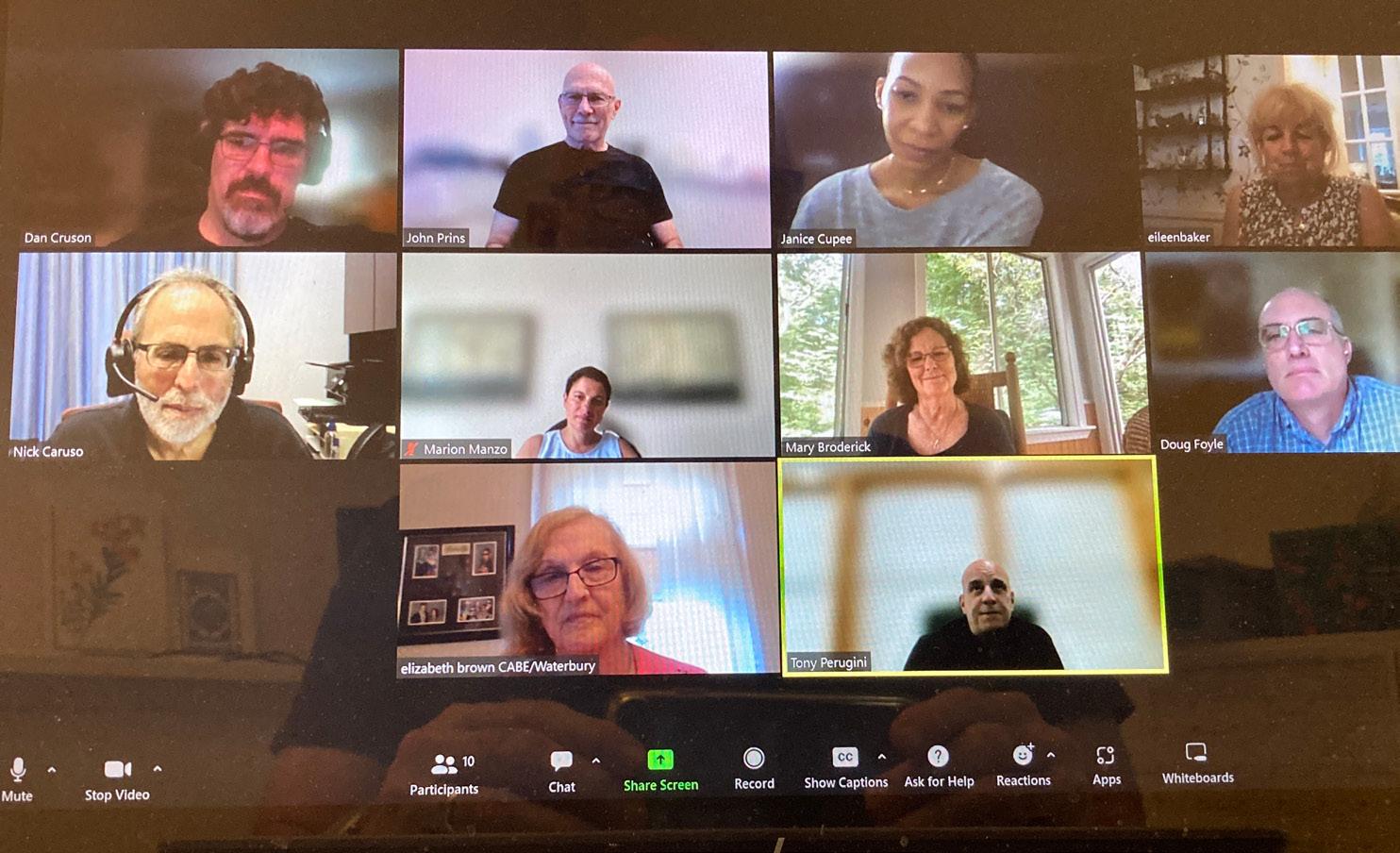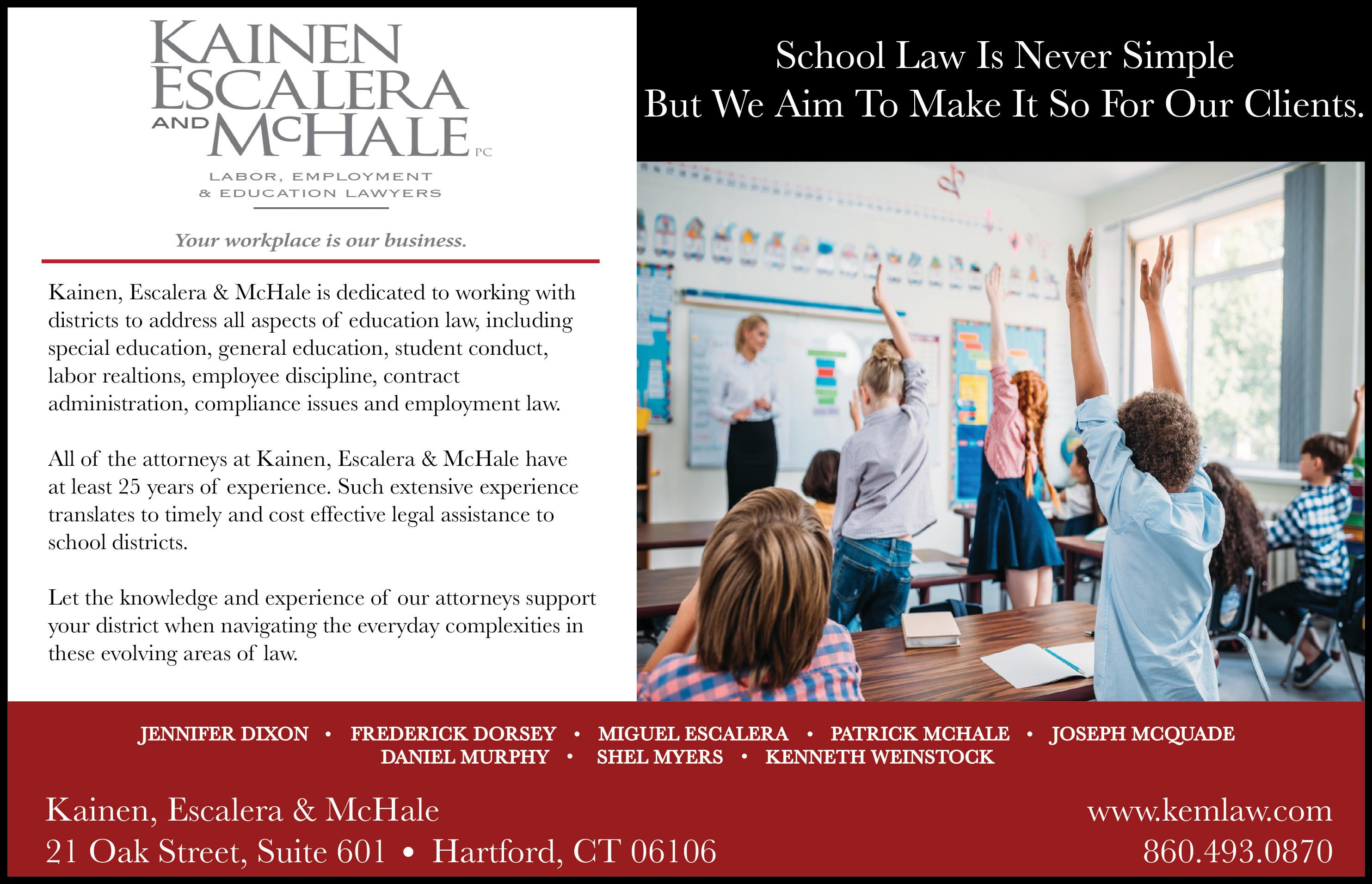
3 minute read
CABE: Working for YOU
Individualized
Below are the highlights of activities that the CABE staff has undertaken on your behalf over the last month. We did this:
Advertisement
By providing opportunities for members to learn how to better govern their districts: z Responded to 60 requests for policy information from 46 districts, providing sample materials on policy topics. Further, districts continue to access CABE’s online Core Policy Reference Manual and/or online manuals posted by CABE for policy samples. The topics of greatest interest were those pertaining to plagiarism, public comment, controversial issues.
By helping school boards to increase student achievement: z Facilitated Board Retreat for the Salem Board of Education. z Sent two issues of “Policy Highlights” via e-mail listserv covering topics that affect student achievement. These issues discussed the topics of student representatives to the board of education and review of new legislation with policy implications.
By providing services to meet member needs: z Participated in CABE DEI Committee meeting. z Led Board Chair Check-Ins. z Provided Legislative Wrap Up workshop. z Staffed meetings of the State Relations, Government Relations and Resolutions Committees. z Responded to a variety of legal, governance and policy inquiries from members. z Revised policies, as part of the Custom Update Policy Service, for Gilbert School, Marlborough, New Fairfield, New Hartford, and Westbrook z Prepared materials, as part of the Custom Policy Service, for Region #14 and Seymour z Currently working on developing new customized policy manual projects for Stratford and Woodbridge. z Currently assisting Groton Board of Education with their high school principal search. z Staffed CABE/CAPSS Convention Committee meeting. z Planned and implemented successful CABE Summer Leadership Conference.
By attending Professional Development to strengthen staff knowledge and skills: z Attended webinar on the impact of AI on education. z Attended New England Society of Association Executives (NESAE) conference. z Attended COSA State Counsel virtual meetings. z Presided over the mid-year meeting of the Connecticut School Attorneys Council. z Attended a webinar by Franklin Covey for the Seven Habits of Leadership for Educators. z Attended the annual conference for the National Federation of School Board Association Trainers and Meeting Planners z Attended the American Association of State Policy Services Conference Workshops included federal case updates, implementing new Title IX regulations, running effective board meetings, and roundtable discussions. z Attended in New England School Public Relations Association (NESPRA) annual conference. z Participated in NESPRA book discussions on Made to Stick: Why Some Ideas Survive and Others Die. z Attended NSPRA Annual Seminar.

By representing Connecticut school boards on the state or national level: z Provided legislative updates at CREC Council meetings. z Facilitated Vermont School Boards Association retreat. z Participated in Social Emotional Learning Collaborative meetings. z Participated in meeting with Commissioner and Education Partners z Participated in Diversifying Educator Workforce meeting. z Attended Teacher Leaders Fellowship Conference z Attended CT School Attorneys Council meeting. z Participated in NSBA State Association Counsel calls. z Attended African American and Latino History presentation. z Participated in Aspiring Special Education Leaders Committee meeting. z Responded to press calls on efforts to increase educator diversity. z Attended School Discipline Collaborative meeting. z Participated in CT ESSER Advisors meeting. z Attended a meeting of the Connecticut Commission for Educational Technology z Attended Discovering Amistad Board of Directors, Ship Committee, and Education Committee meetings. z Participated in New England School Public Relations Association (NESPRA) Executive Committee meeting. z Served on a panel discussing the role of Chapter Treasurer at the Leadership Meeting at the NSPRA Annual Seminar
By helping districts operate efficiently and conserve resources: z Posted policies online, as part of the C.O.P.S. Program for Avon, Barkhamsted, Bethel, Bolton, Brooklyn, Canton, Derby, Granby, Griswold, Monroe, Preston, Region #4, Region #16, Ridgefield, Westport, Wolcott, Woodbridge, and the CABE CORE Manual.

By promoting public education: z Attended CAS Student Equity Board Final Presentations.


Investment Increase
(continued from page 1) paraeducators to the classroom, including expanding paraeducator test sites, test preparation programs, job fairs, and recruitment events held in collaboration with the American Job Centers.
The collaboration will:
• Create two pilot programs statewide to launch the teacher apprenticeship program, which is designed to reduce financial barriers to becoming an educator. The state will support the pilot districts to create a template to expand the program across Connecticut. The teacher Registered Apprenticeship Program will build off the state’s current teacher residency programs and NextGen Educator program.
• Provide seed funding to an additional 18 school districts across the state that are interested in starting an Educators Rising “grow-yourown” high school program, which exposes students to careers in education and feeds into teacher preparation programs at institutions of higher education. Currently, 15 school districts offer the Educators Rising program.
• Fund a joint Connecticut Department of Labor and Connecticut State Department of Education recruitment campaign to attract more educators and paraeducators to the profession to fill approximately 1,300 job openings statewide. Job fairs will include information about current openings, job requirements, paraeducator test requirements, test preparation assistance, and resume writing and coaching. In addition, resources will be dedicated to expanding paraeducator test sites, subsidizing test preparation programs, and the cost of taking the exams.
Overall, staffing levels increased 4 percent between the 2018-2019 and 2021-2022 school years. This represents an increase of more than 4,000 full-time equivalent staff in schools and districts across the state. The percentage of educators of color working in schools has increased to 11.2 percent in 2022-23, up from 8.3 percent in 2015-2016, adding 1,649 new diverse educators.










